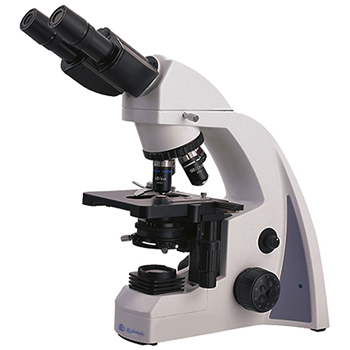The microscope is a device that allows observing elements or structures that cannot be observed with the naked eye, using lenses, viewers and light rays, which bring the image closer or larger in convenient scales for its examination and subsequent analysis.
Microscopes are essential equipment in any laboratory, some represent simple models while others are more complex devices. They have been evolving at accelerated steps, thanks to the development of modern technologies that have allowed the emergence of many types of microscopes with very specific applications, among the most outstanding we can mention:
Compound luminous field microscope
Used to magnify images of objects that are not visible to the naked eye. In the optical microscope the sample is illuminated by visible light. This means that there is a spot of light pointing towards the sample. That same light is conducted through the objective and the eyepiece until it forms the image in the observer’s eye. This is the most common type of microscope, but its resolution is limited by the diffraction of light. The maximum magnification that can be obtained with this type of microscope reaches around 1500x. It is the most common microscope.
Dark field microscope
In this microscope the light rays do not penetrate directly into the object, but it is illuminated obliquely, in this way the illuminated object scatters the light and becomes visible against the dark background. It is used to analyze transparent and unpigmented biological elements, impossible to see in natural light. To achieve this, the equipment has a condenser that illuminates the object with intense but indirect light.
Phase contrast microscope
This microscope allows uncolored cells to be observed, which is why it is very useful for living cells, since as we well know, fixing and staining them implies their death, which can also damage or change their structure. . Its foundation is based on the delay that occurs in light waves when passing through objects of different refractive indices, taking advantage of and amplifying these delays.
Polarized light microscope
Also known as a petrographic microscope. This microscope is actually a type of light microscope to which two polarizers have been added. This means that the light wave used to observe the sample has a specific direction of oscillation. It is very useful for observing crystalline rock and mineral structures.
Stereoscopic microscope
It makes possible the three-dimensional vision of objects, and to achieve this, it uses two eyepieces (those that are close to the eye) and two objectives (those that are near the sample). It is used for relatively large objects, so it requires small magnifications, usually 4X and 40X to 60X.
Fluorescence microscope
Fluorescence is the property that some substances have of emitting their own light when energetic radiation falls on them, that is to say that the object is illuminated with rays of a certain wavelength, the molecules absorb it and emit light with a longer wavelength; for a correct observation it is necessary to place appropriate filters under the condenser and above the objectives.
Inverted microscope
This microscope has an inverse arrangement of its components compared to a conventional microscope. The light and condenser are facing downward and are on the platform, and the targets are below pointing upward. This equipment makes it possible to observe organisms or tissues in culture without prior preparation, which is very useful in, for example, monitoring the growth status, behavior or development of the culture.
At Kalstein we are MANUFACTURERS and we offer you an excellent range of microscopes at the best PRICES on the market. That is why we invite you to take a look at the Products menu. HERE


